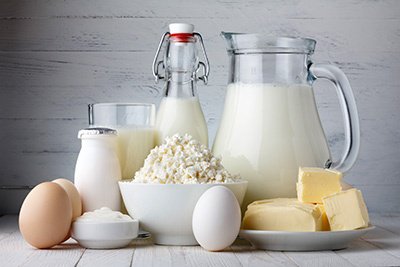I grew up next to a dairy farm in the Midwest and I admit to loving all creamy, full-fat dairy products—milk, cheese, yogurt, ice cream—you name it! You might be like me and feel full-fat dairy is a more rich and flavorful choice versus low-fat or non-fat varieties, but is it a healthier choice?
Some have said recently that full-fat dairy is better for you because it’s less processed and has more fat. So which is it? Is full-fat dairy better or worse than low-fat dairy? Let’s take a closer look.
I’m glad people are starting to realize how overly processed many foods have become. As a Registered Dietitian, I often recommend people choose whole foods and products that are as close to natural as they can find, meaning not a lot of ingredients on the ingredient list.
So, are low-fat dairy products more processed than full-fat dairy? It all starts with milking cows. Regardless of whether the end product is whole milk, 2% milk, 1% milk or skim milk, the milk is skimmed first, meaning that the fat is separated out so that you have cream and non-fat milk. Next, fat is added back to the skim to make milks with the different amounts of fat. It’s then homogenized, a process that evenly distributes the fat molecules, preventing fat from floating to the top of the milk. Milk is also pasteurized, a heat treatment used to kill anything that may cause diseases, like bacteria.
The amount of processing between skim and whole milk is relatively the same. Chemicals are not used in either case, and the only additives to the milks are vitamins A and D.
What about the fat in dairy products—is it healthy fat? Years upon years of scientific research has shown that saturated fat from animal products is not heart-healthy. More than half of the fat in milk is saturated, the type of fat that has been proven to raise LDL or bad cholesterol. Too much LDL stiffens and inflames arteries, which can lead to heart disease. Because there is more fat overall in dairy products, that means there will be more saturated fat in full-fat dairy products. One cup of whole milk or full-fat yogurt a day wouldn’t necessarily put you over your limit for saturated fat, but it could come close. During the course of a day’s worth of foods, saturated fat adds up quickly because anything containing fat (oil, butter, cheese, nuts, chicken) usually has both unsaturated and saturated fat.
To manage your LDL cholesterol, the current national guideline for the amount of saturated fat in your diet is 5-6% of total daily calories. On average, that’s less than 10 grams per day for women and less than 15 grams per day for men. A quick way to see how much saturated fat you usually eat is to keep a food journal for a few days. There are many food and activity trackers on the market today like Lose It! that let you quickly scan food labels. You’ll start to get an idea of which foods have saturated fat and how much.
Bottom line, the argument that full-fat dairy is healthier doesn’t really hold up because more fat overall means more saturated or unhealthy fat.
One other important thing to consider when making your dairy selections is sugar content. You might think you’re eating healthy low-fat or non-fat yogurt until you see it contains more sugar than a Twinkie. Added sugar is the most concerning to heart health. Added sugar can have many names on labels like evaporated organic cane juice, brown rice syrup, agave nectar, concentrated fruit juice—it’s still added sugar and sugar in excess isn’t heart healthy because it raises blood triglycerides.
Now you know that low-fat dairy products are no more processed than full-fat dairy products and full-fat dairy contains more saturated fat overall. Enjoying full-fat dairy products only on rare occasions is fine, but eating mostly reduced-fat products that have no added sugar is a healthier option. This way, you can enjoy dairy products without the worry of putting your heart at risk.
Curious about your ‘fat’ levels? The Boston Heart Fatty Acid Balance™ test measures the major fatty acids.
